引入包:
from learntools.core import binder
binder.bind(globals())
from learntools.machine_learning.ex2 import *
import pandas as pd读取数据:
# Path of the file to read
iowa_file_path = '../input/home-data-for-ml-course/train.csv'
# Fill in the line below to read the file into a variable home_data
home_data = pd.read_csv(iowa_file_path)
home_data.columns #返回所有列的列表
LotArea = home_data.loc[:,"LotArea"] #读取表格中的一列数据
数据预处理:
(删除缺失值只是处理缺失值的方法之一)
home_data = home_data.dropna(axis=0) #dropna()用于删除删除丢失的值,axis=0:按行删除;1:按列删除缺失值处理方法:
- 整列数据删除:
# 提取出含有缺失值的列
cols_with_missing = [col for col in X_train.columns
if X_train[col].isnull().any()]
# 在训练集和测试集中删除含有缺失值的列,得到新的训练集和测试集
reduced_X_train = X_train.drop(cols_with_missing, axis=1)
reduced_X_valid = X_valid.drop(cols_with_missing, axis=1)- 插补法(用这一列的平均值填充缺失值):
from sklearn.impute import SimpleImputer
# 用数据的平均值填充缺失值,得到新的训练集和测试集
my_imputer = SimpleImputer()
imputed_X_train = pd.DataFrame(my_imputer.fit_transform(X_train)) #对X_train计算均值,然后把训练集的缺失值填充平均值
imputed_X_valid = pd.DataFrame(my_imputer.transform(X_valid)) # 对测试值的缺失值进行填充
# Imputation removed column names; put them back
imputed_X_train.columns = X_train.columns
imputed_X_valid.columns = X_valid.columns处理分类变量的方法:
- Drop Categorical Variables 不考虑分类变量对因变量的影响;
#把分类自变量直接剔除,得到新的训练集和测试集
drop_X_train = X_train.select_dtypes(exclude = ['object'])
drop_X_valid = X_valid.select_dtypes(exclude = ['object'])- Ordinal Encoding将分类变量转化成数值:
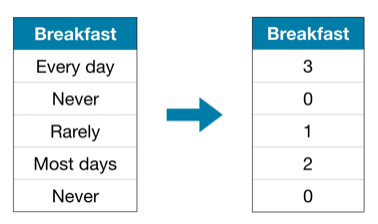
# Categorical columns in the training data
object_cols = [col for col in X_train.columns if X_train[col].dtype == "object"]
# Columns that can be safely ordinal encoded
good_label_cols = [col for col in object_cols if
set(X_valid[col]).issubset(set(X_train[col]))]
# Problematic columns that will be dropped from the dataset
bad_label_cols = list(set(object_cols)-set(good_label_cols))
from sklearn.preprocessing import OrdinalEncoder
#找到训练集和测试集中文本格式的数据,将这些数据都删除
label_X_train = X_train.drop(bad_label_cols, axis=1)
label_X_valid = X_valid.drop(bad_label_cols, axis=1)
#对缺失值进行填充,得到新的测试集和训练集数据
ordinarial_encoder = OrdinalEncoder()
label_X_train[good_label_cols] = ordinarial_encoder.fit_transform(X_train[good_label_cols])
label_X_valid[good_label_cols] = ordinarial_encoder.transform(X_valid[good_label_cols])- One-Hot Encoding:
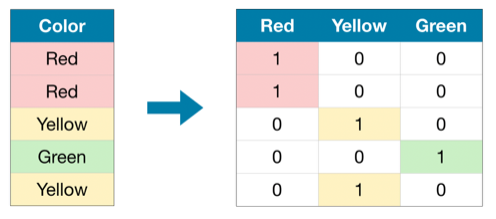
将一列颜色数据转化成红、黄、绿三列数据,“1”代表是,而“0”代表不是。
# Get number of unique entries in each column with categorical data
object_nunique = list(map(lambda col: X_train[col].nunique(), object_cols))
d = dict(zip(object_cols, object_nunique))
# 可以得到每一列的标题及每一列有几类文本
sorted(d.items(), key=lambda x: x[1])
#将分类变量区分为高类别变量与低类别变量
# 低类别变量可以用one-hot
low_cardinality_cols = [col for col in object_cols if X_train[col].nunique() < 10]
# 高类别变量将被剔除
high_cardinality_cols = list(set(object_cols)-set(low_cardinality_cols))
from sklearn.preprocessing import OneHotEncoder
# Apply one-hot encoder to each column with categorical data
OH_encoder = OneHotEncoder(handle_unknown='ignore', sparse=False)
OH_cols_train = pd.DataFrame(OH_encoder.fit_transform(X_train[low_cardinality_cols]))
OH_cols_valid = pd.DataFrame(OH_encoder.transform(X_valid[low_cardinality_cols]))
# One-hot encoding removed index; put it back
OH_cols_train.index = X_train.index
OH_cols_valid.index = X_valid.index
# Remove categorical columns (will replace with one-hot encoding)
num_X_train = X_train.drop(object_cols, axis=1)
num_X_valid = X_valid.drop(object_cols, axis=1)
# Add one-hot encoded columns to numerical features
OH_X_train = pd.concat([num_X_train, OH_cols_train], axis=1)
OH_X_valid = pd.concat([num_X_valid, OH_cols_valid], axis=1)
选择自变量:
构建一个只有几个特征作为自变量和因变量的模型:
y = home_data.SalePrice
# Create the list of features below
feature_names = ['LotArea','YearBuilt','1stFlrSF','2ndFlrSF','FullBath','BedroomAbvGr','TotRmsAbvGrd']
# Select data corresponding to features in feature_names
X = home_data[feature_names]
# Review data
# print description or statistics from X
print(X.describe())
# print the top few lines
print(X.head())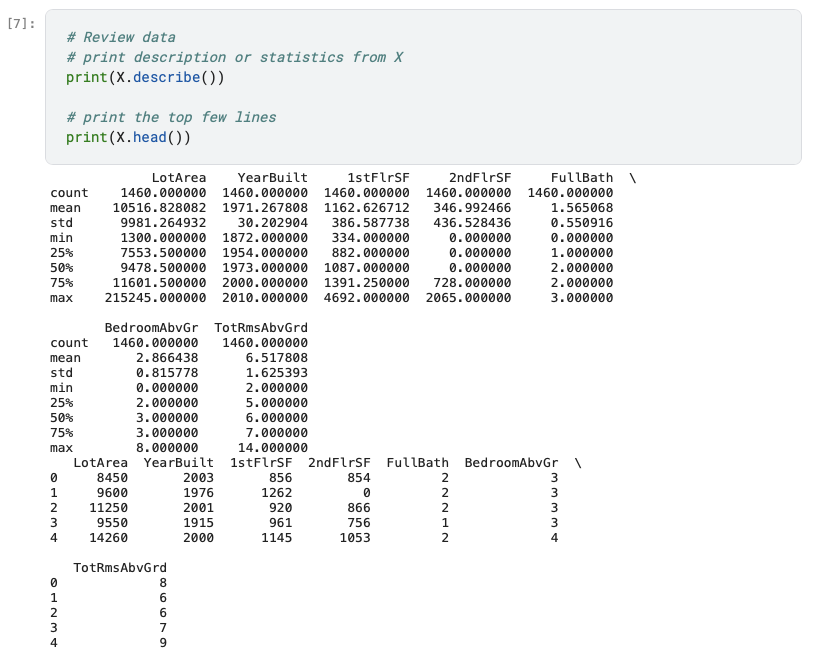
模型搭建、训练和测试:
#将数据集划分为训练集和测试集
from sklearn.model_selection import train_test_split
train_X, val_X, train_y, val_y = train_test_split(X,y,random_state=1)
决策树模型:
from sklearn.tree import DecisionTreeRegressor
#specify the model.
#For model reproducibility, set a numeric value for random_state when specifying the model
iowa_model = DecisionTreeRegressor(random_state=1)
# Fit the model
iowa_model.fit(train_X,train_y)
#predict model
predictions = iowa_model.predict(val_X)随机森林模型:
from sklearn.ensemble import RandomForestRegressor
forest_model = RandomForestRegressor(random_state=1)
forest_model.fit(train_X, train_y)
melb_preds = forest_model.predict(val_X)计算误差:
模型的预测结果与实际值之间的平均绝对误差:
from sklearn.metrics import mean_absolute_error
predicted_home_prices = melbourne_model.predict(val_X)
mean_absolute_error(val_y, predicted_home_prices) #计算模型的平均绝对误差 欠拟合与过拟合:
欠拟合:模型无法捕捉数据中的重要区别和模式,因此即使在训练数据中也表现不佳;
过拟合:一个模型几乎完美地匹配训练数据,但在验证和其他新数据方面表现不佳。
通过控制模型的最大叶子数,逐个输出模型预测值与实际值平均绝对误差,进而比较模型在什么区间内过拟合,选择拟合效果最好的模型:
from sklearn.metrics import mean_absolute_error
from sklearn.tree import DecisionTreeRegressor
def get_mae(max_leaf_nodes, train_X, val_X, train_y, val_y):
model = DecisionTreeRegressor(max_leaf_nodes=max_leaf_nodes, random_state=0)
model.fit(train_X, train_y)
preds_val = model.predict(val_X)
mae = mean_absolute_error(val_y, preds_val)
return(mae)
candidate_max_leaf_nodes = [5, 25, 50, 100, 250, 500]
# Write loop to find the ideal tree size from candidate_max_leaf_nodes
for max_leaf_nodes in candidate_max_leaf_nodes:
my_mae = get_mae(max_leaf_nodes, train_X, val_X, train_y, val_y)
print("Max leaf nodes: %d \t\t Mean Absolute Error: %d" %(max_leaf_nodes, my_mae))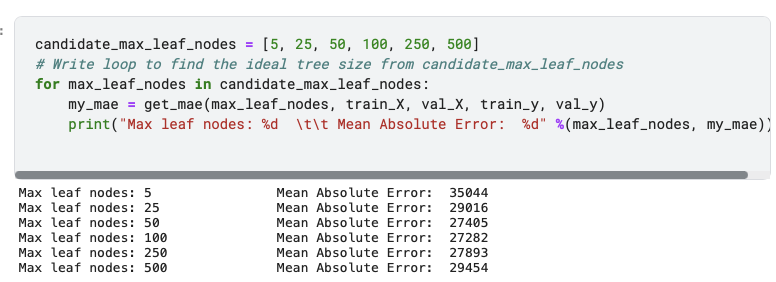
可以看到最大叶子结点数为100时,平均绝对误差最小。
best_tree_size = 100
# 建立新的决策树模型
final_model = DecisionTreeRegressor(max_leaf_nodes=best_tree_size, random_state=1)
# fit the final model and uncomment the next two lines
final_model.fit(X, y)Pipelines:
流水线是将处理数据、搭建模型等代码组装在一起,在使用的时候更方便。
优点:
- 代码更简洁;
- 错误率更低;
- 生产率更高;
- 模型验证的更多选项。
步骤:
- 定义预处理:
1) 在数值数据中输入缺失的值
2)输入缺失值并对分类数据应用one-hot编码
from sklearn.compose import ColumnTransformer
from sklearn.pipeline import Pipeline
from sklearn.impute import SimpleImputer
from sklearn.preprocessing import OneHotEncoder
# Preprocessing for numerical data
numerical_transformer = SimpleImputer(strategy='constant')
# Preprocessing for categorical data
categorical_transformer = Pipeline(steps=[
('imputer', SimpleImputer(strategy='most_frequent')),
('onehot', OneHotEncoder(handle_unknown='ignore'))
])
# Bundle preprocessing for numerical and categorical data
preprocessor = ColumnTransformer(
transformers=[
('num', numerical_transformer, numerical_cols),
('cat', categorical_transformer, categorical_cols)
])- 定义模型:
from sklearn.ensemble import RandomForestRegressor
model = RandomForestRegressor(n_estimators=100, random_state=0)- 创建并评估流水线:
from sklearn.metrics import mean_absolute_error
# Bundle preprocessing and modeling code in a pipeline
my_pipeline = Pipeline(steps=[('preprocessor', preprocessor),
('model', model)
])
# Preprocessing of training data, fit model
my_pipeline.fit(X_train, y_train)
# Preprocessing of validation data, get predictions
preds = my_pipeline.predict(X_valid)
# Evaluate the model
score = mean_absolute_error(y_valid, preds)
print('MAE:', score)交叉验证:
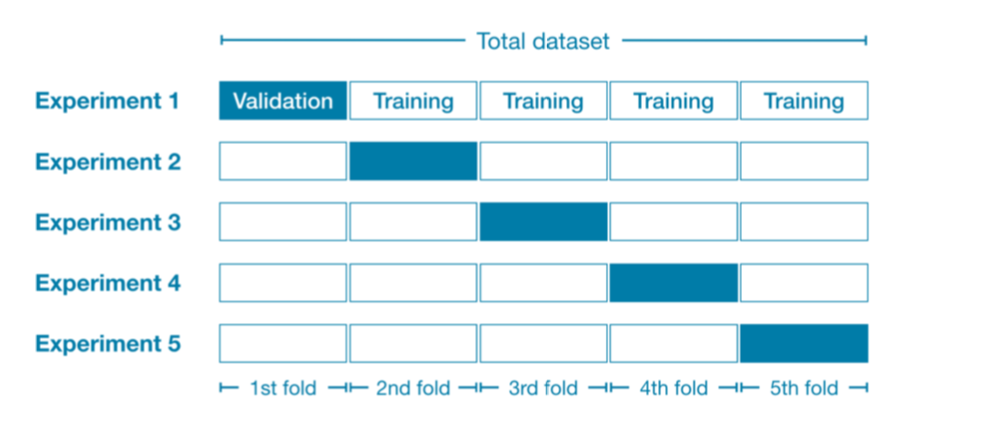
将数据分成5份,第一次把第一份数据集作为验证集,其余四份作为训练集,以此类推,共进行五次实验。
from sklearn.model_selection import cross_val_score
# Multiply by -1 since sklearn calculates *negative* MAE
scores = -1 * cross_val_score(my_pipeline, X, y,
cv=5, #进行五次实验
scoring='neg_mean_absolute_error')
final_score = scores.mean() #取平均梯度增加:
步骤:

XGBoost是梯度增加的一个应用:
from xgboost import XGBRegressor
my_model = XGBRegressor()
my_model.fit(X_train, y_train)XGBRegressor()的参数:
n_estimators表示循环多少次:
my_model = XGBRegressor(n_estimators=500)
my_model.fit(X_train, y_train)learning_rate表示迭代决策树的步长,若learning_rate越小,则越有可能找到更精确的最佳值,但迭代速度也更慢:
my_model = XGBRegressor(n_estimators=1000, learning_rate=0.05)
my_model.fit(X_train, y_train,
early_stopping_rounds=5,
eval_set=[(X_valid, y_valid)],
verbose=False)n_jobs表示:
my_model = XGBRegressor(n_estimators=1000, learning_rate=0.05, n_jobs=4)
my_model.fit(X_train, y_train,
early_stopping_rounds=5,
eval_set=[(X_valid, y_valid)],
verbose=False)my_model = XGBRegressor(n_estimators=500)
my_model.fit(X_train, y_train,
early_stopping_rounds=5, #early_stopping_rounds设置最少循环的次数
eval_set=[(X_valid, y_valid)],
verbose=False)数据泄漏:
数据泄露发生的情况一般是训练数据包含了因变量。数据泄漏的表现一般是训练的模型的准确率异常得好,但实际上预测的结果却很差
分类:
- 目标数据泄露
在所给的数据中有两列数据含有强烈的相关性,虽然在实验数据中,可以得到很好的结果,但在现实生活中很难应用。
- 训练测试数据泄漏
训练集和测试集数据划分的不准确性。
expenditures_cardholders = X.expenditure[y]
expenditures_noncardholders = X.expenditure[~y]
# 挑选出可能会造成数据泄漏的数据剔除
potential_leaks = ['expenditure', 'share', 'active', 'majorcards']
X2 = X.drop(potential_leaks, axis=1)
# Evaluate the model with leaky predictors removed
cv_scores = cross_val_score(my_pipeline, X2, y,
cv=5,
scoring='accuracy')





















 2754
2754











 被折叠的 条评论
为什么被折叠?
被折叠的 条评论
为什么被折叠?








